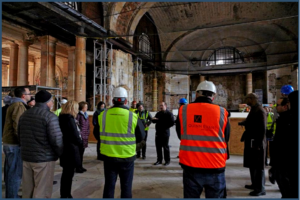Ford Motor this week begins its renovation of 105-year-old Michigan Central Station in the Corktown neighborhood of Detroit. In this Detroit landmark, Ford seeks to shape the largely unknown, amorphous future of transportation at a time when analysts are questioning whether it can survive the next downturn in the business cycle.The project will bring approximately 2,500 Ford employees to Corktown.
The three-phase project begins with the winterization of the building to dry it out from extensive water damage it sustained over the years, and then stabilizing the structure. Phase two includes replacing mechanical and electrical systems and restoring exterior masonry.
The final phase is finishing and restoring the interior. Ford plans to return the grand hall of the station to its original look and attract local shops and restaurants in an inclusive public space.
The building has been open to the elements for years so the work being done first is mainly internal,” said Mary Culler, Detroit development director, Ford Motor Company. “Come spring, things will become more visible to the community.”
In June, Ford acquired the train station and plans to transform it and surrounding properties into a 1.2-million-square-foot “innovation campus” where Ford and its partners will work on autonomous and electric vehicle businesses, and design urban mobility services and solutions.
The project will bring approximately 2,500 Ford employees to Corktown, most from the company’s mobility team, and an additional 2,500 jobs with Ford’s partners and suppliers.
First Steps
Abandoned in 1988, Michigan Central Station has sustained decades of damage from rain and freeze-thaw effect, a process in which temperature changes from freezing to thawing expand cracks and holes in the masonry. The structure absorbed tons of water over the years. Steps must be taken to dry out the building, assess the damage, and plan for repairs and restoration. Leaving the building exposed through another winter would accelerate damage to walls, floors, ceilings and the structure’s historic fabric.
A combination of plywood and tarpaulin will be used to cover open windows and exterior holes on the roof of the 600,000-square-foot structure to prevent more rain and inclement weather damage. A series of pumps will be installed in the basement to prevent further flooding and fans will be placed to circulate air through the building. Using natural ventilation and evaporation is the best way to dry out the building rather than rapid heating systems, which could cause irreparable harm to historic features.
“The building is very lucky Ford stepped in when it did,” said Ronald D. Staley, executive director of the Christman-Brinker joint venture selected as the construction manager for the project. “It would have been a lot more difficult, maybe impossible five to 10 years down the road to salvage.



Pingback: Ford, Newlab Announce Five Cleaner Transportation Startups | AutoInformed